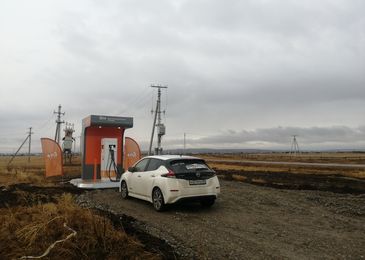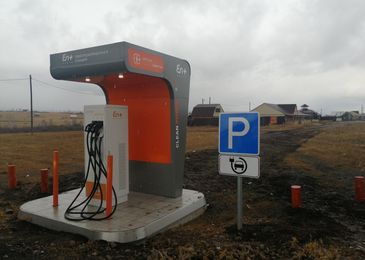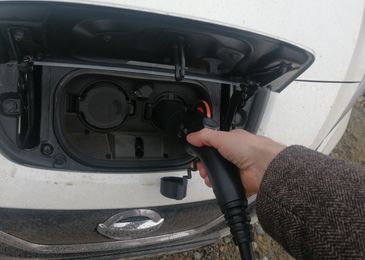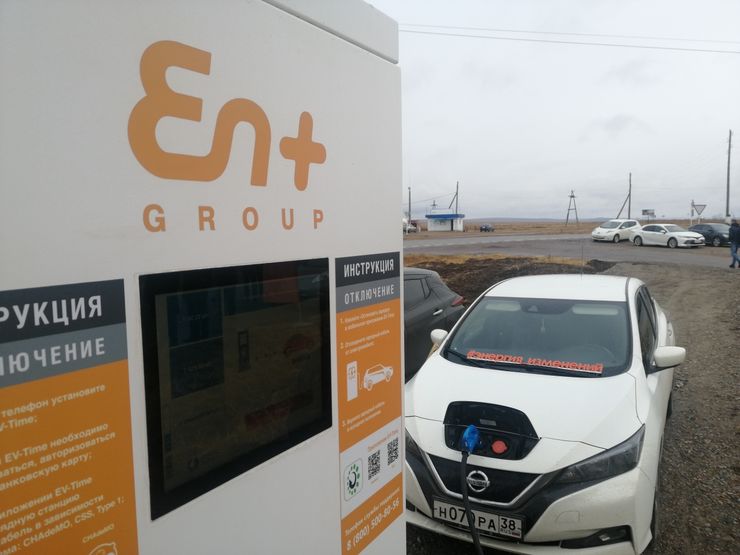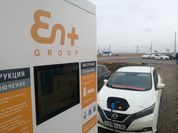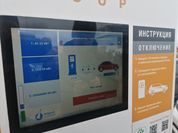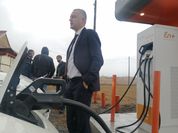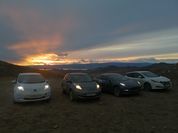The automotive community is split into two camps. Some view electric vehicles as a dead-end branch of auto industry development, while others are “drowning” as petrol and diesel cars are about to meet the fate of dinosaurs, and the future belongs to electric trains. By the way, large companies have also joined the camp of supporters of “high voltage”, actively participating in the development of a network of electric filling stations in Russia. Portal “AvtoVzglyad” visited the opening of another “socket”.
Three electric test stations of the company En+ Group appeared in December 2020 in Irkutsk and in the village of Listvyanka, on the shores of Lake Baikal. Contrary to the predictions of skeptics, “recharging” quickly found its customers, which prompted the founder of this project, businessman Oleg Deripaska, to open a whole network of gas stations in the Irkutsk region. At the end of October, three more petrol stations were put into operation and we attended the opening.
Lost “alien” cargo
It’s a rather strange feeling when in an open field where cows graze, there is a state-of-the-art design with LED backlighting and incomprehensible connectors on power wires. Everything glows, flashes… You might think that a spaceship flew by, from the cargo hold from which such an unusual device accidentally fell. The EZS looks painfully futuristic against the background of local landscapes. But apparently this is how new technologies are breaking through in the most remote corners of the country.
Five more “power outlets” from this company should appear in the region in the next month, so the total number of electric car service stations in the region will be 18 units. This means that it will be even easier for owners of “green” cars to travel around Baikal.
Although even now it is possible to get from Irkutsk to the island of Olkhon with electric traction, as we have personally seen, without any problems, since there are corresponding charging stations every 70-90 kilometers. True, they are not yet displayed on navigation maps, and therefore owners of “non-traditional” vehicles must download the appropriate application on their smartphone in advance.
Pseudo-green ecology
Our trip to the main island of Lake Baikal and back was on Tesla and Nissan Leaf electric vehicles. Depending on the capacity of the batteries installed on the test cars, the electric trains have sufficient range for a distance of 250 to 500 kilometres. True, it should be noted that in cold weather you can roll out a “full tank” twice as fast, especially if the battery on the car is not the first freshness. And installing new batteries is so expensive.
For the same Leaf, a 40 kW lithium-ion battery costs 600-650 thousand rubles, which is half the price of a not very used car. However, as one of the owners of the electric car participating in our run assured us, with proper operation of the electric train, the battery will last at least 10 years.
You see, by then batteries that have served their time will learn to recycle 100% as the problem of their disposal is now on the edge.
The impossibility of getting rid of “dead” batteries without harming nature destroys the arguments of the “green” batteries, frothing at the mouth, proving that electric vehicles are incredibly environmentally friendly. Moreover, the production of batteries for electric cars poisons the mother planet no worse than the entire fleet of petrol cars put together.
entertaining math
But if scientists can make batteries more environmentally friendly in the near future, then electric cars will indeed start to supplant their petrol and diesel counterparts. After all, the costs of a kilometer on the road are even now significantly lower.
Calculate for yourself: at the En + Group gas station, the cost of one kW of electricity is 16 rubles, multiply by the capacity of the car’s nutrients (on our Leaf, the “tank volume” is 70 kW) and we get the amount to pay 1120 rubles. In the summer, an electric car with the headlights and radio consumes 16 kW of “fuel” per 100 kilometers, which is 256 in monetary terms. “A full tank” is enough for about 430 kilometers.
A car of the same class as the Nassan Leaf, but with a gasoline engine “eats” about 8 liters of AI-95 per “hundred”, which is almost 500 rubles in money. And if an electric car is “refueled” at home, where the price of a kilowatt at night for the capital region is about 4 (in the Irkutsk region, 1 kW at night costs … 1 ruble!), then a ” full tank” costs a ridiculous 280 rubles. That is, 100 kilometers costs 64 rubles!
Just over 19,000 electric vehicles are registered in Russia. The lion’s share falls on the Nissan brand – 12,300 units. As for Tesla, there are only 2,400 in the country. But this is also a good result compared to Porsche – we have 837 German electric cars. Rounding out the top five are electric trains from Audi (718) and Mitsubishi (497).
One “ambush”: if you live not in the private sector, but in an apartment building, not all neighbors will appreciate the extension cord that goes to the car from the 9th floor.
Three electric test stations of the company En+ Group appeared in December 2020 in Irkutsk and in the village of Listvyanka, on the shores of Lake Baikal. Contrary to the predictions of skeptics, “recharging” quickly found its customers, which prompted the founder of this project, businessman Oleg Deripaska, to open a whole network of gas stations in the Irkutsk region. At the end of October, three more petrol stations were put into operation and we attended the opening.
Lost “alien” cargo
It’s a rather strange feeling when in fact, in an open field where cows graze, there is a state-of-the-art design with LED backlighting and incomprehensible connectors on power wires. Everything glows, flashes… You might think a spaceship flew past, out of the cargo hold where such an unusual thing accidentally fell out. The EZS looks painfully futuristic against the background of local landscapes. But apparently this is how new technologies are breaking through in the most remote corners of the country.
Five more “power outlets” from this company should appear in the region in the next month, so the total number of electric car service stations in the region will be 18 units. This means that it will be even easier for owners of “green” cars to travel around Baikal.
Although even now it is possible to get from Irkutsk to the island of Olkhon with electric traction, as we have personally seen, without any problems, since there are corresponding charging stations every 70-90 kilometers. True, they are not yet displayed on navigation maps, and therefore owners of “non-traditional” vehicles must download the appropriate application on their smartphone in advance.
Pseudo-green ecology
Our trip to the main island of Lake Baikal and back was on Tesla and Nissan Leaf electric vehicles. Depending on the capacity of the batteries installed on the test cars, the electric trains have sufficient range for a distance of 250 to 500 kilometres. True, it should be noted that in cold weather you can roll out a “full tank” twice as fast, especially if the battery on the car is not the first freshness. And installing new batteries is so expensive.
For the same Leaf, a 40 kW lithium-ion battery costs 600-650 thousand rubles, which is half the price of a not very used car. However, as one of the owners of the electric car participating in our run assured us, with proper operation of the electric train, the battery will last at least 10 years.
You see, by then batteries that have served their time will learn to recycle 100% as the problem of their disposal is now on the edge.
The impossibility of getting rid of “dead” batteries without harming nature destroys the arguments of the “green” batteries, frothing at the mouth, proving that electric vehicles are incredibly environmentally friendly. Moreover, the production of batteries for electric cars poisons the mother planet no worse than the entire fleet of petrol cars put together.
entertaining math
But if scientists can make batteries more environmentally friendly in the near future, then electric cars will indeed start to supplant their petrol and diesel counterparts. After all, the costs of a kilometer on the road are even now significantly lower.
Calculate for yourself: at the En + Group gas station, the cost of one kW of electricity is 16 rubles, multiply by the capacity of the car’s nutrients (on our Leaf, the “tank volume” is 70 kW) and we get the amount to pay 1120 rubles. In the summer, an electric car with the headlights and radio consumes 16 kW of “fuel” per 100 kilometers, which is 256 in money. “A full tank” is enough for about 430 kilometers.
A car of the same class as the Nassan Leaf, but with a gasoline engine “eats” about 8 liters of AI-95 per “hundred”, which is almost 500 rubles in money. And if an electric car is “refueled” at home, where the price of a kilowatt at night for the capital region is about 4 (in the Irkutsk region, 1 kW at night costs … 1 ruble!), then a ” full tank” costs a ridiculous 280 rubles. That is, 100 kilometers costs 64 rubles!
Just over 19,000 electric vehicles are registered in Russia. The lion’s share falls on the Nissan brand – 12,300 units. As for Tesla, there are only 2,400 in the country. But this is also a good result compared to Porsche – we have 837 German electric cars. Rounding out the top five are electric trains from Audi (718) and Mitsubishi (497).
One “ambush”: if you live not in the private sector, but in an apartment building, not all neighbors will appreciate the extension cord that goes to the car from the 9th floor.
Source: Avto Vzglyad
I’m Sandra Torres, a passionate journalist and content creator. My specialty lies in covering the latest gadgets, trends and tech news for Div Bracket. With over 5 years of experience as a professional writer, I have built up an impressive portfolio of published works that showcase my expertise in this field.








